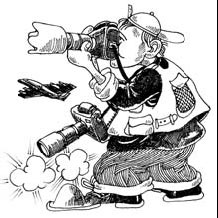Li Xing
Is only bad news good photography?
By Li Xing (China Daily)
Updated: 2007-02-16 12:30
 |
Large Medium Small |
 As the night editor on February 14 two years ago, I had racked my brain along with my colleagues to choose the lead photo for the front page the next day.
As the night editor on February 14 two years ago, I had racked my brain along with my colleagues to choose the lead photo for the front page the next day.
We'd wanted to break the routine of Spring Festival coverage in China.
Then around 8:30 pm, news broke that former Lebanese Prime Minister Rafik Hariri had been assassinated in Lebanon. However much sympathy my colleagues and I had for the prominent Lebanese politician, we sighed with relief that we had the most newsworthy photo at hand wreckage of his motorcade on Beirut's seafront with rescuers carrying an injured man.
In a way, that response is common to newsrooms worldwide, as testified to by this year's World Press Photo Contest winners.
The organizers declare on the contest website that the winning photos offer "an overview of how press photographers tackle their work worldwide and how the press gives us the news, bringing together pictures from all parts of the globe to reflect trends and developments in photojournalism."
While praise for the award-winning photos abounds, I've discovered that there are people who question the jury's values in making their choices. And I think the criticism offers food for second thoughts about photojournalism and journalism as well.
"Brutal scenes filled with blood, violence, killings are just rampant among the prize-winning pictures," one Chinese netizen commented on the coverage of the contest at sina.com.
"The photo (2rd prize singles for spot news) 'Public execution of suspected collaborator in Jenin, West Bank, August 13' is real enough, but did the jury consider the feelings of the readers?" the netizen continued. "Does it mean that the photographer could only achieve perfection by capturing an execution?
"Should news only cover the ugliness and the sinister in the world?" the netizen concluded.
 The Chinese netizen is not alone. At blog.photoblogs.org, a netizen named Craig wrote: "Overall the photos are stunning but, other than sports, the theme seems to be war and suffering. I guess it opens the eyes of the 99 percent of the world that is not at war (including me) but I wonder if it's partly a morbid curiosity that makes these photos compelling."
The Chinese netizen is not alone. At blog.photoblogs.org, a netizen named Craig wrote: "Overall the photos are stunning but, other than sports, the theme seems to be war and suffering. I guess it opens the eyes of the 99 percent of the world that is not at war (including me) but I wonder if it's partly a morbid curiosity that makes these photos compelling."
Naturally many journalists do not agree with these responses. World Press Photo jury chair Michele McNally describes the winning images as having "the complexity and contradiction of real life amid chaos" and making people "look beyond the obvious".
"I have been a witness, and these pictures are my testimony. The events I have recorded should not be forgotten and must not be repeated," said James Nachtwey, the world-famous master of photography.
I couldn't help but admire the work of Nachtwey when I paged through his photo documentaries of famine and genocide in Africa, religious conflicts in the Middle East, wars in Iraq and the 9/11 terrorist attacks in New York.
But I believe we journalists must also take the netizens' comments seriously, as the Chinese netizen said: "There are still many things beautiful out there in this world."
And "I sure would like to see more winners from some stories of hope!"
While we don't want the cruelty and the suffering repeated, we journalists also have a duty to show where hope lies and how we can work together to help relieve the agony, get rid of wars and poverty and make the world a better place to live.
Such hope is seen in the photo of a young visually impaired woman learning Latin ballroom dancing. Taken by (Paul) Zhang Tao, a photographer with the Beijing News, the photo won the 3rd prize singles in the Arts and Entertainment category of the World Press Photo contest.
E-mail: lixing@chinadaily.com.cn
| 分享按钮 |